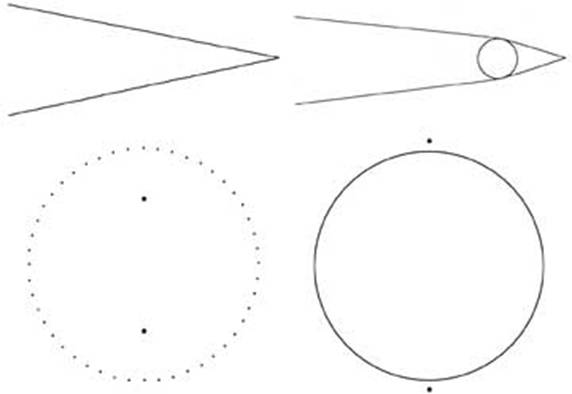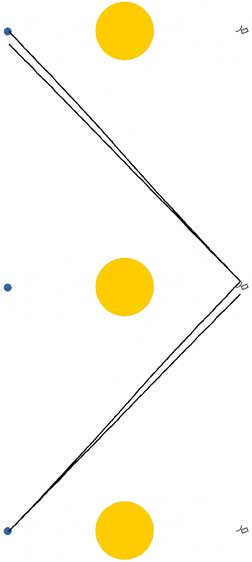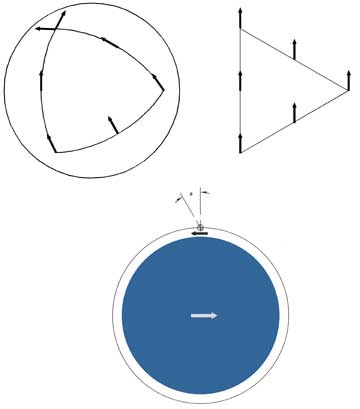A B C
D E F
E. Further Tests
The reality checks didn't stop there. In his
early discussions of general relativity, Einstein described several other
consequences of the theory. Observations of some of these consequences
commenced soon after Einstein's early publications, and have continued since.
One interesting consequence was that everything, including
light, should be affected by gravity in the same way. One of Einstein's
thought-experiments with the "space elevator" involved shining a light
as the elevator moved in various ways. If the elevator were in steady,
unaccelerated motion, any beam of light shining inside the elevator would be
straight. If the elevator accelerated upward, the beam would still be
straight as seen by an unaccelerated outside observer, but from the perspective
of the elevator's passengers, any non-vertical beam would be deflected downward.
Since the elevator's acceleration produces the same basic
effects as gravity, Einstein realized that an ordinary gravitational field
should also deflect a light beam. The earth's gravity, like accelerations
small enough to simulate it, deflects light too little to make the deflection
obvious, but larger accelerations or masses greater than the earth's can produce
a measurable effect. For instance, the sun should deflect any light
skimming its surface by just over 3 microradians (1.7 arcseconds)—a very small angle, but
measurable. The sun would thus focus any beams of light that passed near
its surface, like a magnifying lens, thereby making the sources of such beams
look as though they were spread further apart than they really were. It's
difficult to see beams of light graze the sun when the sun is out, unless the
sun is eclipsed. Photographs of the May 1919 solar eclipse provided the
first confirmation that light was deflected by gravity. Today, astronomers
take this effect for granted. When they find multiple similar images close
together in the sky, they recognize that some large mass is bringing two or more
different sets of light waves from the same object into view, much as a lens
would, and they calculate the location and size of the "lens" mass
from measurements of the multiple images.

Figure
7.
On the left, rays of light converging toward the earth from different stars
undeflected by the sun's gravity (top); if the sun were between the stars and
the earth, and the sun's gravity had no effect on the rays, the sun would block
these particular stars from view (bottom). On the right, with the sun
between the same stars and the earth, the rays from the stars are deflected by
the sun (top), and (bottom) the resulting view from the earth (assuming the sun
is eclipsed to make the stars visible). The deflection is exaggerated here
to make it obvious; on the scale of this figure, the actual repositioning of the
stars' images between the bottom left and bottom right would be on the order of
one micrometer.
Einstein
found that not only does gravity curve the paths of light as it does the paths
of everything else, it also desynchronizes time. Where spacetime isn't
curved, time passes at the same rate everywhere. Where gravity exists, and
spacetime is curved, time runs faster wherever the curvature is weaker.
This
effect manifests itself in several ways, some of them involving things that
vibrate at some steady rate. Atoms in the outer layers of the sun absorb
light waves that vibrate at particular frequencies. This makes the
sunlight of these frequencies that we get on Earth less intense than it would be
otherwise. We find that the same types of atoms on Earth also absorb light
waves, but at slightly higher frequencies. This is what general relativity
theory leads us to expect. The gravity at the sun's surface is stronger
than that at Earth's surface, so the spacetime curvature near the sun is
greater, and time near the sun proceeds at a slower rate. From the
perspective of an atom that moved between Earth and the sun, the frequencies of
light it could absorb are the same in both places; but to us on Earth, since
time on the sun flows more slowly, the atom's "same frequency" is to
us a lower frequency. An identical effect can be observed in the light
from other stars the
frequencies absorbed by atoms near their surfaces are lower than those absorbed
by the same types of atoms in Earth's weaker gravity.
Although
Earth's gravity is much weaker, with the right instruments
we can see the
same effect here. In the late 1950s and mid 1960s, Robert Pound, Glen
Rebka, and Joseph Snider demonstrated that gamma rays increased their
frequencies by 2.4 parts per quadrillion as they rose 74 feet through a
tower against gravity. This indicated that time flowed 1.000 000 000 000 002 4 times
faster at the top of the tower than at the bottom, the difference again matching
what Einstein's equation G
= 8 πκ T/c4 implies for
the curvature of spacetime near Earth's surface.
A
more precise test, known as Gravity Probe A, was conducted in
1976, when a hydrogen maser clock was taken on a 115-minute rocket flight with a
maximum altitude of 10,000 kilometers. As the rocket rose and fell through
the earth's gravitational field, its clock registered more time than a similar
clock on the ground, the difference matching the prediction of general
relativity for the different rates of time flow in the different regions of the
gravitational field.
Nowadays,
though, it doesn't take special experiments to demonstrate a relation between
gravity and the flow of time; two modern utilities demonstrate it every day in
their normal operation. The worldwide system of timekeeping is based on
atomic clocks stationed at different places on Earth. The clocks at
Boulder, Colorado, which are at a much higher altitude than others in the United
States, measure the faster rate of their local time; these clocks require
adjustment to keep the slower pace of the worldwide "official"
time. A newer utility, the Global Positioning System, has to deal with a
more pronounced manifestation of the same effect. This location system is
based on time signals from atomic clocks in Earth orbit, where time flows faster
still. If the difference in the rate of time between the satellites and
the ground were not taken into account, the system would give wildly inaccurate
location readings within only one day of operation.
Modern
space technology has provided other tests of relativity that Einstein hadn't
proposed. One test is similar to that of our imaginary two-dimensional
man's survey. Just as curvature in his two-dimensional space can alter
distances, like the diameters of his circles, curvature can change distances in
our spacetime. Irwin Shapiro noted in 1964 that if spacetime is curved
near massive objects as Einstein's formula predicts, signals sent through the
spacetime around those objects will take longer to reach their destinations than
they would without the curvature. This had been checked by radar signals
reflected from the plants Mercury and Venus, and by radio communications with
space probes elsewhere in the solar system, when the line of sight to each
passed near the sun. The signals' round trips take about 200 microseconds
longer than they would have if the spacetime near the sun weren't curved—a
small difference in our ordinary experience, but a significant difference in our
modern age of devices that readily measure durations of nanoseconds (thousandths
of a microsecond).

Figure 8. In this figure,
the position of two different radar signals moving from the earth, then past the
sun, then reaching a space probe, and then moving back the other way, is
represented by points on straight or (slightly) curved lines. The
horizontal direction represents the signal's position in space; the vertical
direction represents the passage of time. The lower line in each direction
(earth to probe, probe to earth) shows how the signal would proceed in straight
lines if spacetime were not curved. Near the sun, spacetime is curved
more, which means the straightest possible path for the radar signal is itself a
curve—scarcely
different from a straight line at large distances from the sun, but less like a
straight-line signal close to the sun. Because of this curvature, the
signal takes longer than it otherwise would to make a round trip from the earth
to the space probe and back again. Observing how the signal's travel time
varies as the earth and the space probe both move and change their alignment
with the sun reveals that when the radar signal passes near the sun, the
signal's trip to the probe and back is lengthened by some 200 microseconds—the
equivalent of 60 extra kilometers.
At
this writing, the newest space-based test (Gravity Probe B)
measures a quite different effect of curvature. If spacetime were not
curved, any device set up to point in a fixed direction could be taken on any
round trip one chose, and as long as no torques were ever applied to the device,
it would still point in the same direction when it returned to where it
started. But try to move a similar device through a curved spacetime, and
the right kind of round trip would end up changing the device's orientation,
even if the device never underwent a torque. This aspect of spacetime
curvature has recently been sought near the earth with a set of gyroscopes
placed on a satellite known as "Gravity Probe B". Gyroscopes
keep their orientation as long as there are no torques on them and there is no
curvature in the spacetime they move through. The gyroscopes on the
satellite were carefully kept from undergoing significant torque, but their
orbit is through a region of spacetime that, according to Einstein's formula, is
curved enough to reorient them by a known, measurable amount. If it turns
out that their orientation has changed by this amount, the experiment will have
shown us a new type of evidence for the reality of spacetime curvature.

Figure
9.
An arrow made to slide over a globe without being twisted clockwise or
counterclockwise can still change direction simply because of the globe's own
curvature (top left)—something that would not happen if the arrow slid over a
plane without being twisted (top right). Similarly, a gyroscope's axis can
change as the gyroscope moves through a curved spacetime (bottom). The
axis of a gyroscope orbiting over the earth's north and south poles would
gradually change its orientation, mostly within the plane of the gyro's orbit
(as shown), but also with some precession about an axis parallel to that of the
earth's rotation. The gyroscopes on Gravity Probe B would have to keep
spinning for about 4000 centuries for their axes to make the first kind of
change by the amount shown here (π/6 radians); on this scale, the second
kind of change would make the gyroscope's axis point just a few micrometers out
of the page. Over the 16 months of the actual experiment, the angle of the
gyro's axis should have changed by only a few tens of microradians in the plane
of its orbit, and a few tenths of a microradian perpendicular to this plane.
(.....continued)
A B C
D E F








